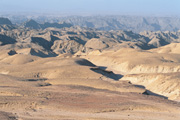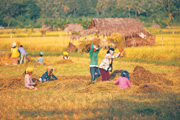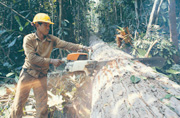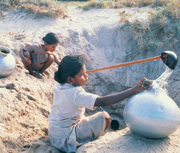Severe sandstorms are usually caused by both natural and contrived factors, that is, climatic, geographical, social and human factors.
by Liu Jianhui
Natural Factors in the Formation of Severe Sandstorms
As mentioned above, the severe sandstorms in northwest China are closely related with the atmospheric, topographical and vegetation conditions.

Topographical factor
Landforms and landscapes play a leading role in the formation of sandstorms. In northwest China, mountains alternate with basins, and plateaus are connected with plains. For example, the Zhunge'er Basin is located between the Tianshan and Altai mountains; and the Tarim Basin is situated between the Tianshan and Kunlunshan mountains. To the south of Gansu are the Qilianshan and Aerjin mountains, and to its north is the bulge region of the Alxa Plateau-Northern Mountains flatlands. The plain of Gansu is situated between them. The landforms, which may increase gradients of air pressure and temperature, play a leading and strengthening role in the formation of sandstorms.
Sandstorms often occur in and mainly affect arid and semi-arid areas in the middle latitudes, which are also endangered by desertification. The desert in Mongolia, together with the desert in the eastern part of Kazakhstan, forms one of the two major sources of the country's sandstorms.
Nearly one third of China's western regions, especially Inner Mongolia and the Xinjiang Uygur Autonomous Region, are also experiencing serious desertification, making them another sandstorm source. The environment along the route of the storms determines their severity in north and northeast China
In arid and barren areas, large stretches of deserted land and sandy land provide rich sources for sandstorms. In areas under the protection of shelterbelts, sparse forests can protect an area 24-38 times that of the height of the trees, which can reduce the wind speed by 34 to 41 percent on average. The preventive force of shelterbelts is obvious.
Experts agree that the dusty weather in Beijing is mainly because of the desertification of vast grazing lands and plains in Inner Mongolia Autonomous Region, Hebei and Shanxi provinces, all located north of the capital.
The soil in those dry areas contains a high proportion of sand. Exploiting the land for all - and, sadly more than it can sustain - sowed the seeds of disaster. Experiments have proved strong winds carry dust particles to 3,000 kilometres or beyond. Deserts in Gansu Province and Xinjiang Uygur Autonomous Region, which are thousands of miles away, can also supply sandstorm sources for Beijing.

Atmospheric factors
In recent years, sandstorms have been occurring more frequently, with enhanced intensity and expanded scale. This is, to some degree, related to the frequent spells of unusual weather and the global climatic changes over the past century.
Aside from desertification, experts believed that this winter's warm weather is also a culprit for the sandstorm.
Due to the inactivity of cold fronts in the region, Beijing has had one of the warmest winters in history this year. The temperature reached 15.4C on January 4, the highest in the city's meteorological history, according to Zhang Mingying, senior engineer with the Beijing Meteorological Observatory.
The Beijing region is dominated by continental and monsoon climates,swherestemperatures rise or drop very quickly. These sharp temperature changes also cause springtime gusts.
Experts said that affected by Mongolia cyclone, from Tuesday to Wednesday's afternoon, sandstorm covered most areas of northwest China and the northern and western areas of north China, including Beijing, together with five to seven degree strong wind.
Contrived factors in the formation of severe sandstorms
Human activities play an important role in the formation of severe sandstorms. There are two main aspects: One is the improper use of land. An analysis by the United Nations Environment Program shows that of all the degraded land in general, 34.5 percent has been caused by over-grazing, 29.5 percent by the destruction of forests, 28.1 percent by the inappropriate use of agricultural land, and 7.95 percent resulted from improper use of water resources, industrial and mineral production and transportation. The situation in China is similar to this. The other factor is population growth and the rapid spread of urbanization, which increases pressure on productive land and will lead to short-sighted activities by peasants and herdsmen, who seek to improve their living standards by intensified economic activities. Major human activities affecting the climate are as follows:

Excessive cultivation of farmland:
Of the land opened up in the past 10 years, one half has already been abandoned. From 1986 to 1996, the National Agricultural Administration Office conducted a satellite remote-sensing survey covering 53 counties or county-level cities in Heilongjiang, Inner Mongolia, Gansu and Xinjiang. The result demonstrates severe grassland and forest destruction in those districts. In the 10 years, about 1.74 million hectare of land was cultivated, but only 884,000 hectares remained cultivated, accounting for 50.8 percent of the total. The three great waves of cultivation since the 1950s, destroyed large stretches of natural vegetation, which later further deterioratedsintosbare, sandy land. With neither condition for cultivation nor protective measures, many areas became desertified.

Deforestation
Snatching their own profit, people intensified denudation in the past. Because of excessive felling of trees, the ecosystem of the western regions has no vitality at all, except the drifting sand. The area of diversiform-leafed poplar forest along the lower reaches of the Tarim River has decreased by 75 percent--from 53,000 hectare in the 1960s to 1,333 hectare at present. The Bashang area of Hebei Province is a transition zone from grassland to forest. Due to over-cutting, the ecological environment has been seriously damaged. According to satellite-produced data, the area of forests here decreased by 38.82 percent from 363,500 hectare in 1987 to 222,400 hectare in 1996, while the area of drifting sand increased by 81 percent from 68,000 hectare to 129,100 hectare.

Over-grazing:
Over-grazing has led to serious grassland degeneration. 70 percent of the grassland in northwest China has been degraded. The overloading rate of livestock breeding is 50-120 percent, and as high as 300 percent in some areas. With the increase in the number of grazing animals in the region, the livestock was forced to eat everything available, from plants over ground to roots below just to survive. The result: the exposed land swiftly transformedsintosa virtual desert. The serious drought hitting North China for three successive years only served to exacerbate the situation.

Excessive use of water resources:
Water resources in the arid and semi-arid areas of northwest China mainly come from rainfall, surface runoff and underground water. For many years, there has been great waste in the use of water resources due to lack of scientific management. Also, excessive irrigation is found on the upper reaches of rivers. Serious water shortages and uneven distribution of water resources have caused difficulties in water use, and the death of natural desert forest and vegetation in northwest China.

Ineffective protection of constructive sites:
In March 15’s sandy weather, the sand came mainly from construction sites in Beijing city. The sand from thousands of miles away mostly would drop while it is drifting along, on the condition that the wind is not so strong. The government has announced that the construction sites might be fined up to RMB 10,000 if they did not take effective protecting measures.
| ![]() 本网站由北京信息港提供网络支持
本网站由北京信息港提供网络支持






